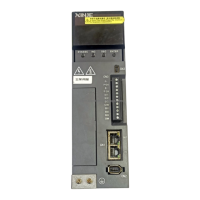(a2) Z phase number (P9-11.0) is 0 and mechanical offset (P9-19, P9-20) is not 0:
In the operation process of continuing to search the rising edge of deceleration point (origin) signal at
low speed with P9-13 (homing low speed), stop immediately when encountering the rising edge of
deceleration point (origin) signal. After the motor is completely stopped, the motor will move a
quantitative pulse (P9-19, P9-20) with speed P9-12 (homing high speed) according to the set number of
mechanical offset pulses and direction (either positive direction or negative direction), then the motor
will stop.
(a3) Z phase number (P9-11.0) is 1 and mechanical offset (P9-19, P9-20) is 0:
During the operation of continuing to search the rising edge of deceleration point (origin) signal at low
speed P9-13 (homing low speed), continue to run after encountering the rising edge of deceleration
point (origin) signal, and then find the first Z-phase signal and stop immediately.
(a4) Z phase number (P9-11.0) is 1 and mechanical offset (P9-19, P9-20) is not 0:
During the operation of continuing to search the rising edge of the deceleration point (origin) signal at
low speed P9-13 (homing low speed), continue to run after encountering the rising edge of the
deceleration point (origin) signal, then find the first z-phase signal and stop immediately. After the
motor is completely stopped, according to the set number of mechanical offset pulses (P9-19, P9-20)
and direction (it can be positive direction or negative direction), the motor goes through a quantitative
pulses (P9-19, P9-20) at the speed set by P9-12 (homing high speed), and then the motor stops.
(b) When the motor starts to move, the origin switch (deceleration point) signal is valid (P5-64 =
0-invalid, 1-valid), and the forward overtravel switch (P5-22) is not triggered in the whole
process:
The servo motor directly searches for the falling edge of the deceleration point (origin) signal at low
speed -P9-13 (homing low speed). If it encounters the falling edge of the deceleration point (origin)
signal, it will reverse (i.e. forward), and continue to search for the rising edge of the deceleration point
(origin) signal at low speed with P9-13 (homing low speed). The next homing action can be divided
into four cases:
(b1) Z phase number (P9-11.0) is 0 and mechanical offset (P9-19, P9-20) is 0:
In the process of forward acceleration or forward constant speed operation, stop immediately when
encountering the rising edge of deceleration point (origin) signal.

